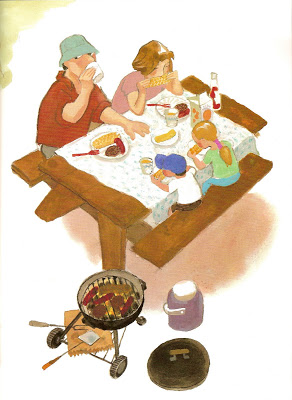
Asked and Answered | March 23, 2016

Image from The Stray Dog, by Marc Simont
Which classic picture book illustrator/author do you wish you could have collaborated with?
“Without question, E. B. White. I am currently illustrating a picture book biography of his life, written by the wonderful Barbara Herkert, and I’ve been immersed in ‘E. B. White World’ for the past couple months. I have read detailed biographies on his life, researched the locations where he grew up and where he wrote his books, scavenged for White family photos, and have read and reread much of what he published during his lifetime. I enjoyed White’s Charlotte’s Web as a child, but reading this book as an adult with new knowledge of the incredible person behind that story, now holds a much deeper meaning. E. B. White said, “All that I hope to say in books, all that I ever hope to say, is that I love the world.” As an illustrator who strives to leave her heart on the page, I cannot think of another author I wish I had the opportunity to collaborate with more.” — Lauren Castillo, author/illustrator of Newberry Honor book Nana and the City and illustrator of the forthcoming Twenty Yawns by Jane Smiley
“I’m grateful that this hard-to-choose question seems to rule out anybody living, because I harbor secret daydreams about working with oh-so-many longtime and newly classic illustrators—and crushes are embarrassing. I think Margaret Wise Brown would have been an invigorating mentor and collaborator. She so fabulously and constantly activated her empathy, respect, and admiration for the full humanity of kiddos into books and interactive, playful ideas. I once worked in, and was much inspired by, the City and Country school, which comes from the progressive world of Bank Street education Margaret Wise Brown was such a part of. Of course kid-Caron did make many additions to Goodnight Moon, so, you know, we actually have collaborated. (I should also mention that kid-Caron wrote several new adventures for Corduroy she would’ve liked to submit to Don Freeman for consideration.)” — Caron Levis, author of Ida, Always
“Before I start, what actually qualifies someone as a ‘classic’ illustrator? If they were winning Caldecott Honors before I was born, that counts, right? If so, then I’m going with Stephen Gammell! His line work, his splatters, his incredibly unique ability to convey energy and motion through his marks has always excited me. Any quiet white space left on a page becomes entirely activated—interrupted, really—by his use of vibrant, overlapping color. His picture books are loud and funny and they never sit still. I love high-energy stories that brim with emotion and color and I’d be honored to have his art splashed across my text any day.” — Elise Parsley, author and illustrator of If You Ever Want to Bring an Alligator to School, Don’t!
“I would love to collaborate with Tomi Ungerer. Hell, I’d love to just hang out with Tomi Ungerer. His illustration style is so simple and expressive and his sensibility is so totally unique. I’ve been a huge fan of Crictor and The Three Robbers since I was a kid but after watching the documentary Far Out Isn’t Far Enough, I really fell in love with the guy. I went onto eBay and bought every old book I could get my hands on. So subversive. So funny. It really is bonkers how many iconic and wildly diverse images he created throughout his legendary career. If he’s still up for a collaboration at 84, I’ll fly to Ireland tomorrow.” — Adam Rubin, author of Dragons Love Tacos and Robo-Sauce
“I first encountered Marc Simont’s work at a local bookstore, when The Stray Dog caught my eye. A dog rescuer twice over, I was slayed by the story; but more than that, I was enchanted by the art: the confidence and economy of line and color, the expressive body language of the characters and the powerful compositions which control the story’s tension. Just watch that car drive away on the left hand page, a single pair of hands outstretched toward the tiny stray alone, nothing to ground him, on the right (sob!). Feel Willy’s fear as he crouches from beneath the warden’s net, his pointed finger condemning the dog. Now feel Willy’s joy–head raised, eyes smiling, tail dancing–when the children pull off their belts to give him a collar, a leash and a life.
A decade later, I wrote a story called Leaf, and I thought of Marc Simont to illustrate it. I had heard he was “older,” but, to me, his art was young and vibrant. It was then I learned that this brilliant illustrator of nearly 100 children’s books had published The Stray Dog at 85 (!) and had recently died, at the age of 97. What an honor it would have been to work with him.” — Randall de Sève, author of A Firetruck Named Red
“I would have loved to collaborate with Maurice Sendak. He was able to transpose all types of emotions and experiences into the format of the picture book, speaking honestly to kids without talking down to them. I admire his inventiveness and sense of humor, and the rhythm of his words. Also, he reminds me of my grandmother whose skepticism was tempered with a love of beauty and playfulness. Whatever the amorphous essence of childhood is that so many adults leave behind, she kept it, and I feel like he did, too.” — Jessica Young, author of the Haggis and Tank series







